Abstract
Our experience with 121 coronary vein (CV) leads in 116 patients shows that CV leads are the leads of choice for pacing the left ventricle (LV). The information gained from pre-operative venous angiography permits individual selection of the most appropriate lead model for each case. The use of steerable electrophysiology catheters facilitates guide catheter cannulation of the coronary sinus (CS) when the anatomy is difficult and reduces the risk of complications. By selecting the CV lead model most suitable for each individual patient, we achieved successful implantation in 99.1% of patients. In this day and age, epicardial electrodes should be restricted to cases with CS anomalies which make CS cannulation impossible, and to LV lead implantation during heart surgery.
Similar content being viewed by others
References
Auricchio A, Stellbrink C, Block M, Sack S, Vogt J, Bakker P, Klein H, Kramer A, Ding J, Salo R, Tockman B, Pochet T, Spinelli J. Effect of pacing chamber and atrioventricular delay on acute systolic function of paced patients with congestive heart failure. Circulation 1999; 99: 2993–3001.
Gras D, Mabo P, Tang T, Luttikuis O, Chatoor R, Pedersen AK, Tscheliessnigg HH, Deharo JC, Puglisi A, Silvestre J, Kimber S, Ross H, Ravazzi A, Paul V, Skehan D. Multisite pacing as a supplemental treatment of congestive heart failure: preliminary results of the Medtronic Inc. InSync Study. PACE 1998; 21 (11Pt.II): 2249–2255.
Kass DA, Chen CH, Curry C, Talbot M, Berger R, Fetics B, Nevo E. Improved left ventricular mechanics from acute VDD pacing in patients with dilated cardiomyopathy and ventricular delay. Circulation 1999; 99: 1567–1573.
Stellbrink C, Auricchio A, Diem B, Breithardt OA, Kloss M, Schoendube FA, Klein H, Messmer BJ, Hanrath P. Potential benefit of biventricular pacing in patients with congestive heart failure and ventricular tachyarrhythmia. Am J Cardiol 1999; 83: 143D–150D.
Daubert C, Leclercq C, Le Breton H, Gras D, Pavin D, Pouvreau Y, Van Verooij P, Bakels N, Mabo P. Permanent left atrial pacing with specifically designed coronary sinus lead. PACE 1997; 20(11): 2755–2764.
Walker S, Levy T, Paul VE. Dissection of the coronary sinus secondary to pacemaker lead manipulation. PACE 2000; 23: 541–543.
Vogt J, Lamp B, Meissner A, Hansky B, Schmidt F, Tenderich G, Koerfer R, Horstkotte D. Pre-implant coronary sinus venogram and hemodynamic testing in patients selected for biventricular pacing in congestive heart failure. PACE 2000; 23(4 Pt.II): 657.
Author information
Authors and Affiliations
Corresponding author
Rights and permissions
About this article
Cite this article
Hansky, B., Vogt, J., Gueldner, H. et al. Left Heart Pacing—Experience with Several Types of Coronary Vein Leads. J Interv Card Electrophysiol 6, 71–75 (2002). https://doi.org/10.1023/A:1014140716802
Issue Date:
DOI: https://doi.org/10.1023/A:1014140716802




